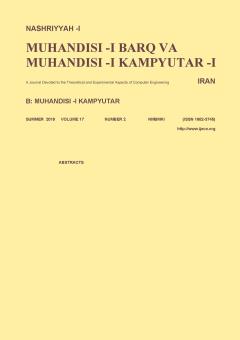تحلیل و بررسی تأثیر پارامترهای طراحی فلیپفلاپ استاتیک بر مشخصههای زمانی و توان مصرفی آن در تکنولوژی 16 نانومتر
الموضوعات : electrical and computer engineeringاحسان محمودی 1 , مرتضی قلی پور 2
1 - دانشگاه صنعتی نوشیروانی بابل
2 - دانشگاه صنعتی نوشیروانی بابل
الکلمات المفتاحية: پارامترهای زمانیتوان مصرفیفلیپفلاپ استاتیک,
ملخص المقالة :
فلیپفلاپ یکی از عناصر مهم در طراحی مدارهای دیجیتال است که کارایی آن در سرعت و توان مصرفی سیستم بسیار تأثیرگذار میباشد. در این مقاله با انجام شبیهسازیهای مناسب، پارامترهای زمانی فلیپفلاپ استاتیک به دست آمده و تأثیر ابعاد ترانزیستورهای مختلف بر این پارامترها مورد بررسی قرار گرفته است. سپس با تغییر ولتاژ تغذیه و پارامترهای فرایند ساخت، میزان تأثیر تغییرات این عوامل بر کارایی فلیپفلاپ مورد ارزیابی قرار گرفته است. عرض ترانزیستورهای مدار بر اساس دستیابی به حاصلضرب انرژی- تأخیر (EDP) و حاصلضرب توان- تأخیر (PDP) مطلوب در دو حالت به صورت مجزا تعیین شدهاند. سپس تأثیر تغییرات ولتاژ بر افزایش EDP و PDP در مقایسه با فلیپفلاپ پایه مورد بررسی و ارزیابی قرار گرفته است. فلیپفلاپ مورد بررسی در این مقاله فلیپفلاپ استاتیک نوع D میباشد. شبیهسازیها با استفاده از نرمافزار HSPICE در تکنولوژی 16 نانومتر و در فرکانس نامی GHz 1 انجام شده است.
[1] S. Bernard, M. Belleville, J. Legat, A. Valentian, and D. Bol, "Ultra-wide voltage range pulse-triggered flip-flops and register file with tunable energy-delay target in 28 nm UTBB-FDSOI," Microelectronics J., vol. 57, Issue C, pp. 76-86, Nov. 2016.
[2] H. Jiang, H. Zhang, T. R. Assis, B. Narasimham, B. L. Bhuva, W. T. Holman, and L. W. Massengill, "Single-event performance of sense-amplifier based flip-flop design in a 16-nm bulk FinFET CMOS process," IEEE Trans. on Nuclear Science, vol. 64, no. 1, pp. 477-482, Dec. 2017.
[3] L. Yang, X. Zhang, Q. Zhang, M. Tan, and Y. Yu, "A high-speed small-area pixel 16×16 ISFET array design using 0.35-μm CMOS process," Microelectronics J., vol. 79, pp. 107-112, Sept. 2018.
[4] Y. Li, L. Chen, I. Nofal, M. Chen, and R. Wong, "Modeling and analysis of single-event transient sensitivity of a 65 nm clock tree," Microelectronics Reliability, vol. 87, pp. 24-32, Aug. 2018.
[5] M. Y. Tsai, P. Y. Kuo, J. F. Lin, and M. H. Sheu, "An ultra-low-power true single-phase clocking flip-flop with improved hold time variation using logic structure reduction scheme," in Proc. IEEE Int. Symp. on Circuits and Systems, ISCAS’18, 4 pp., Florence, Italy, 27-30 May 2018.
[6] B. Aparna and V. Anandi, "Design of a D flip flop for optimization of power dissipation using GDI technique," in Proc. 2nd IEEE Int. Conf. on Recent Trends in Electronics, Information & Communication Technology, RTEICT’17, pp. 172-177 Bangalore, India, 19-20 May 2017.
[7] H. NathSaha et al., "Performance optimization in flip flop circuit design," in Proc. IEEE 8th Annual Computing and Communication Workshop and Conf., CCWC’18, pp. 421-423, Las Vegas, NV, USA, 8-10 Jan. 2018.
[8] T. Lee, D. Z. Pan, and J. S. Yang, "Clock network optimization with multibit flip-flop generation considering multicorner multimode timing constraint," IEEE Trans. on Computer-Aided Design of Integrated Circuits and Systems, vol. 37, no. 1, pp. 245-256, Apr. 2018.
[9] S. Heo and R. Krashinsky, "Activity-sensitive flip-flop and latch selection for reduced energy," IEEE Trans. on Very Large Scale Integration (VLSI) Systems, vol. 15, no. 9, pp. 1060-1064, Sept. 2007.
[10] Y. T. Liu, L. Y. Chiou, and S. J. Chang, "Energy-efficient adaptive clocking dual edge sense-amplifier flip-flop," in Proc. IEEE Int. Symp. Circuits Systems, ISCAS’06, pp. 4329-4332, 21-24 May 2006.
[11] P. Zhao, T. K. Darwish, and M. A. Bayoumi, "High-performance and low-power conditional discharge flip-flop," IEEE Trans. Very Large Scale Integr. (VLSI) Syst., vol. 12, no. 5, pp. 477-484, May 2004.
[12] N. H. E. Weste and D. M. Harris, CMOS VLSI Design-a Circuits and Systems Perspective, 4th Edition, Addison-Wesley, 2015.
[13] A. R. Palaniappan and L. Siek, "Wide-input dynamic range 1 MHz clock ultra-low supply flip-flop," Electronics Letters, vol. 54, no. 15, pp. 938-939, 12 Jun. 2018.
[14] P. Bhattacharjee, B. Nath, and A. Majumder, "LECTOR based clock gating for low power multi-stage flip flop applications," in Proc. Int. Conf. on Electronics, Information, and Communication, ICEIC’17, pp. 106-109, Phuket, Thailand, 11-14 Jan. 2017.
[15] K. Liao, X. Cui, N. Liao, and T. Wang, "Design of D flip-flops with low power-delay product based on FinFET," in Proc. 12th IEEE Int. Conf. on Solid-State and Integrated Circuit Technology, ICSICT’14, 3 pp. 1-3, Guilin, China, 28-31 Oct. 2014.
[16] P. Dobriyal, K. Sharma, M. Sethi, and G. Sharma, "A high performance D-flip flop design with low power clocking system using MTCMOS technique," in Proc. 3rd IEEE Int. Advance Computing Conf., IACC’13, pp. 1524-1528, Ghaziabad, India, 22-23 Feb. 2013.
[17] M. A. Sobhan Bhuiyan, A. Mahmoudbeik, T. I. Badal, M. Bin Ibne Reaz, and L. F. Rahman, "Low power D flip-flop serial in/parallel out based shift register," in Proc. Int. Conf. on Advances in Electrical, Electronic and Systems Engineering, ICAEES’16, pp. 180-184, Putrajaya, Malaysia, 14-16 Nov. 2016.
[18] S. D. Pyle, H. Li, and R. F. DeMara, "Compact low-power instant store and restore D flip-flop using a self-complementing spintronic device," Electronics Letters, vol. 52, no. 14, pp. 1238-1240, 26 May 2016.
[19] -, Predictive Technology Model, [Online]. Available: http://ptm.asu.edu/


